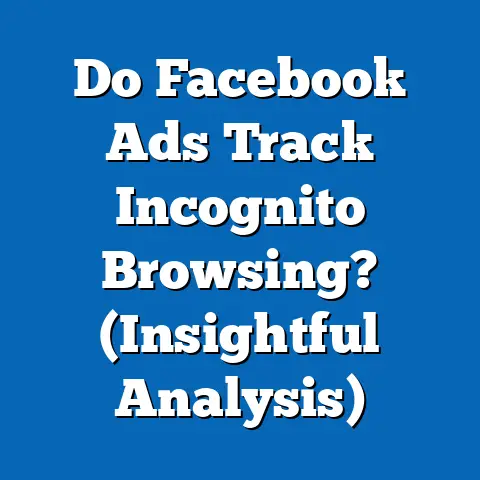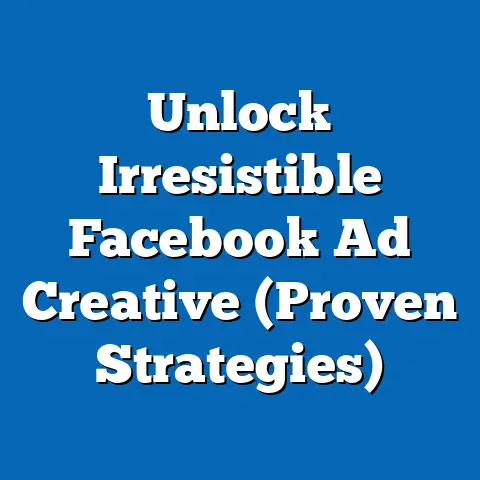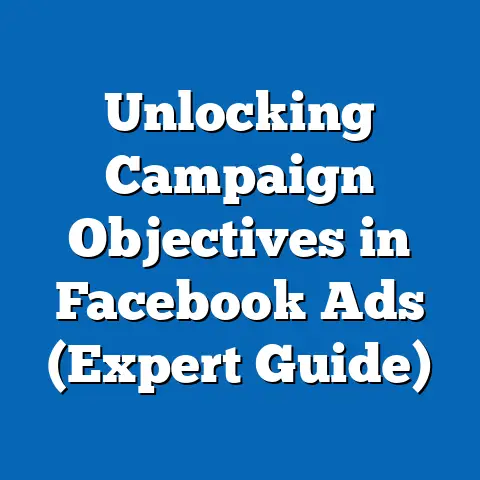Understanding Facebook Ads Policy 2025 (Essential Insights)
Imagine Sarah, a vibrant entrepreneur with a passion for sustainable fashion. She launched her online boutique, “EcoChic Threads,” brimming with excitement to share her eco-friendly designs with the world. Sarah, like many new business owners, saw Facebook as the perfect platform to reach her target audience. She envisioned captivating ads showcasing her unique clothing line, driving traffic to her website, and building a loyal customer base.
However, Sarah quickly encountered a roadblock: Facebook Ads Policy. Her initial attempts to create ads were met with disapprovals, leaving her frustrated and confused. Ads promoting her eco-friendly materials were flagged for “unsubstantiated claims,” and even simple product showcases were rejected due to “misleading content.” Sarah felt like she was navigating a minefield, unsure of what she could and couldn’t say.
That’s when Sarah realized that understanding Facebook Ads Policy wasn’t just a formality – it was the key to unlocking the platform’s potential. She dedicated herself to learning the ins and outs of the policy, attending webinars, reading countless articles (like the one you’re reading now!), and even joining online communities to connect with other marketers facing similar challenges.
Her dedication paid off. Armed with a deep understanding of Facebook’s guidelines, Sarah revamped her ad strategy. She focused on providing verifiable information about her materials, using authentic customer testimonials, and creating visually appealing ads that complied with all the rules. Soon, her ads were approved, her website traffic soared, and EcoChic Threads became a thriving online business.
Sarah’s story is a powerful reminder of the importance of staying updated with Facebook’s policies. In the ever-evolving world of digital marketing, Facebook remains a dominant force, connecting businesses with billions of potential customers. But to harness its power effectively, businesses must navigate its complex advertising policies. As we approach 2025, understanding these policies is more crucial than ever for businesses looking to thrive on the platform.
Section 1: Overview of Facebook Ads Policy Evolution
To truly understand the current state of Facebook Ads Policy in 2025, it’s essential to take a look back at its evolution. From its humble beginnings in 2004 to its current sophisticated form, Facebook’s advertising policies have undergone significant transformations, reflecting changes in technology, user behavior, and societal norms.
In the early days of Facebook, advertising was relatively simple. Ads were often text-based and targeted based on basic demographic information like age and location. The policies were less stringent, and enforcement was less sophisticated. As the platform grew and advertising became more sophisticated, Facebook began to introduce more comprehensive policies to address issues like spam, fraud, and misleading content.
One of the most significant turning points in the evolution of Facebook Ads Policy was the rise of data privacy concerns. The Cambridge Analytica scandal in 2018 brought data privacy to the forefront of public consciousness, forcing Facebook to re-evaluate its data collection and usage practices. This led to stricter rules around user data, transparency, and consent.
Another key factor shaping Facebook Ads Policy has been the rise of artificial intelligence (AI). AI is now used extensively in ad targeting, content moderation, and policy enforcement. While AI has the potential to improve the effectiveness and efficiency of advertising, it also raises concerns about bias, discrimination, and transparency.
Over the years, Facebook has also had to adapt to changes in advertising formats and placements. The introduction of video ads, carousel ads, and stories ads has required Facebook to develop specific policies to address the unique challenges associated with each format.
Here’s a timeline of some major changes and updates that have shaped the current landscape:
In my experience, the advertisers who proactively address policy changes are the ones who thrive. I’ve seen businesses that initially struggled with compliance turn their fortunes around by investing in training for their marketing teams and implementing robust review processes for their ads.
As we move forward into 2025, the trend towards stricter policies and greater transparency is likely to continue. Advertisers who are proactive and adaptable will be best positioned to navigate the ever-changing landscape of Facebook advertising.
Key Takeaway: Understanding the historical context of Facebook Ads Policy is crucial for navigating the current landscape. By recognizing the major changes and updates that have shaped the policy over time, advertisers can better anticipate future trends and adapt their strategies accordingly.
Section 2: Key Components of Facebook Ads Policy 2025
Facebook Ads Policy in 2025 is a complex and comprehensive set of guidelines that govern what advertisers can and cannot do on the platform. It’s essential to understand the core components of this policy to create effective and compliant ad campaigns. Let’s break down the key elements:
Advertising Standards
Advertising Standards outline the types of content that are prohibited on Facebook. These standards are designed to protect users from harmful, offensive, and misleading content. Some of the key areas covered by Advertising Standards include:
- Prohibited Content: This includes hate speech, discrimination, violence, illegal activities, and content that promotes or glorifies self-harm.
- Misleading Claims: Advertisers are prohibited from making false or unsubstantiated claims about their products or services. This includes claims about health benefits, financial gains, or product performance.
- Deceptive Practices: Advertisers are not allowed to use deceptive or manipulative tactics to trick users into clicking on their ads. This includes clickbait, fake news, and impersonation.
- Offensive Content: Advertisers are prohibited from using offensive language, imagery, or content that is likely to offend or alienate users.
- Sensitive Topics: Advertisers must exercise caution when advertising on sensitive topics such as politics, religion, and social issues. They must ensure that their ads are respectful and do not exploit or sensationalize these topics.
For example, I once worked with a client who was promoting a weight loss product. Their initial ad copy included claims about guaranteed weight loss in a short period. This ad was immediately rejected because it violated the prohibition against unsubstantiated claims. We revised the ad copy to focus on the product’s ingredients and how they support a healthy lifestyle, and the ad was subsequently approved.
Targeting and Data Use
Targeting and Data Use policies govern how advertisers can target their ads to specific audiences and how they can use user data for advertising purposes. These policies are designed to protect user privacy and prevent discrimination. Some of the key areas covered by Targeting and Data Use policies include:
- Audience Targeting: Advertisers can target their ads based on a variety of factors, including demographics, interests, behaviors, and connections. However, they are prohibited from using targeting options that discriminate against protected groups, such as race, ethnicity, religion, gender, sexual orientation, and disability.
- Custom Audiences: Advertisers can create custom audiences by uploading customer lists or using website pixel data. However, they must obtain consent from users before collecting their data and must comply with all applicable privacy laws.
- Lookalike Audiences: Advertisers can create lookalike audiences by identifying users who share similar characteristics with their existing customers. However, they must ensure that their lookalike audiences do not disproportionately target protected groups.
- Data Collection and Use: Advertisers must be transparent about how they collect and use user data. They must provide users with clear and concise information about their data practices and must obtain consent before collecting sensitive data.
I remember a campaign where we wanted to target users interested in specific political issues. We carefully reviewed Facebook’s policies on political advertising to ensure that we complied with all the requirements, including disclosing the source of funding for the ads and verifying our identity.
Ad Format and Placement
Ad Format and Placement policies govern the different types of ads that are available on Facebook and where those ads can be placed. These policies are designed to ensure that ads are visually appealing, relevant to users, and do not disrupt the user experience. Some of the key areas covered by Ad Format and Placement policies include:
- Ad Formats: Facebook offers a variety of ad formats, including image ads, video ads, carousel ads, and stories ads. Each format has specific requirements and best practices.
- Ad Placements: Ads can be placed in various locations on Facebook, including the News Feed, right column, Instagram, and Messenger. Each placement has different characteristics and user expectations.
- Ad Creative: Advertisers must ensure that their ad creative is visually appealing, relevant to their target audience, and complies with all applicable policies.
- Landing Pages: Advertisers must ensure that their landing pages are relevant to their ads, provide a positive user experience, and comply with all applicable policies.
For example, video ads must meet specific length and aspect ratio requirements. Carousel ads must have high-quality images and compelling headlines. Stories ads must be engaging and attention-grabbing.
Here are some examples to illustrate how these components manifest in real advertising scenarios:
- Scenario 1: Promoting a Dietary Supplement: An advertiser wants to promote a dietary supplement on Facebook. They must ensure that their ad copy does not make any unsubstantiated claims about the product’s health benefits. They must also ensure that their targeting options do not discriminate against any protected groups.
- Scenario 2: Running a Political Campaign: A political candidate wants to run ads on Facebook. They must comply with all of Facebook’s policies on political advertising, including disclosing the source of funding for their ads and verifying their identity.
- Scenario 3: Promoting a Mobile App: A mobile app developer wants to promote their app on Facebook. They must ensure that their ad creative is visually appealing and accurately represents the app’s features. They must also ensure that their landing page provides a seamless user experience.
By understanding these key components of Facebook Ads Policy, advertisers can create effective and compliant ad campaigns that reach their target audience and achieve their business goals.
Key Takeaway: Facebook Ads Policy in 2025 is a complex and comprehensive set of guidelines. Understanding the core components of this policy, including Advertising Standards, Targeting and Data Use, and Ad Format and Placement, is crucial for creating effective and compliant ad campaigns.
Section 3: Compliance and Enforcement Mechanisms
Facebook has implemented a range of mechanisms to ensure compliance with its advertising policies. These mechanisms are designed to detect and prevent policy violations, protect users from harmful content, and maintain the integrity of the advertising ecosystem.
Automated Systems
One of the primary mechanisms for policy enforcement is automated systems. Facebook uses AI and machine learning to scan ads for potential violations. These systems can detect a wide range of policy violations, including hate speech, misleading claims, and prohibited content.
When an ad is submitted to Facebook, it is automatically reviewed by these systems. If the systems detect a potential violation, the ad may be flagged for further review by human reviewers.
Human Reviewers
In addition to automated systems, Facebook also employs a team of human reviewers who are responsible for reviewing ads that have been flagged by the automated systems or that have been reported by users.
Human reviewers are trained to identify policy violations and to make decisions about whether to approve or reject ads. They also provide feedback to advertisers about why their ads were rejected and how they can revise their ads to comply with the policies.
User Reporting
Facebook also relies on users to report ads that they believe violate the policies. Users can report ads by clicking on the “Report Ad” link in the upper right corner of the ad.
When an ad is reported by a user, it is reviewed by Facebook’s team of human reviewers. If the reviewers determine that the ad violates the policies, it may be removed from the platform.
Penalties for Policy Violations
Advertisers who violate Facebook’s advertising policies may face a range of penalties, including:
- Ad Rejection: The most common penalty for policy violations is ad rejection. If an ad violates the policies, it will be rejected and will not be shown to users.
- Account Suspension: In more severe cases, Facebook may suspend an advertiser’s account. This means that the advertiser will no longer be able to run ads on the platform.
- Permanent Ban: In the most egregious cases, Facebook may permanently ban an advertiser from the platform. This means that the advertiser will never be able to run ads on Facebook again.
I’ve seen firsthand the consequences of policy violations. I worked with a client who repeatedly violated Facebook’s policies by making unsubstantiated claims about their products. After multiple ad rejections and warnings, their account was eventually suspended. They lost access to their advertising account and had to start from scratch with a new account.
Here are some case studies of brands that faced penalties for policy violations:
- Case Study 1: Fashion Nova: Fashion Nova, a popular online fashion retailer, was accused of using deceptive practices in its ads. The company was accused of using fake countdown timers and other tactics to trick users into making purchases. As a result, Fashion Nova faced a lawsuit from the Federal Trade Commission (FTC) and was forced to pay a settlement of $2.9 million.
- Case Study 2: Herbalife: Herbalife, a multi-level marketing company that sells dietary supplements, has been accused of making misleading claims about its products. The company has been investigated by the FTC and has been forced to pay a settlement of $200 million.
- Case Study 3: Cambridge Analytica: Cambridge Analytica, a political consulting firm, was involved in a major data privacy scandal in 2018. The company was accused of harvesting data from millions of Facebook users without their consent and using that data for political advertising purposes. As a result, Cambridge Analytica was forced to shut down.
These case studies highlight the importance of complying with Facebook’s advertising policies. Violations can result in significant penalties, including ad rejection, account suspension, permanent ban, and legal action.
Lessons Learned:
- Prioritize Compliance: Make compliance a top priority in your advertising strategy. Ensure that your ads comply with all of Facebook’s policies.
- Stay Informed: Stay up-to-date on the latest policy changes and updates. Facebook regularly updates its policies, so it’s important to stay informed.
- Review Your Ads: Regularly review your ads to ensure that they comply with the policies.
- Seek Guidance: If you’re unsure about whether your ads comply with the policies, seek guidance from Facebook or a qualified advertising consultant.
Key Takeaway: Facebook has implemented a range of mechanisms to ensure compliance with its advertising policies. Advertisers who violate the policies may face significant penalties. By prioritizing compliance, staying informed, and seeking guidance, advertisers can avoid these penalties and maintain a positive relationship with Facebook.
Section 4: The Role of Transparency and User Trust
In the age of increasing data privacy concerns, transparency and user trust have become more critical than ever in Facebook advertising. Users are more aware of how their data is being collected and used, and they are demanding greater transparency from advertisers.
Facebook has recognized the growing importance of transparency and has taken steps to promote it on the platform. One of the key initiatives is the Ad Library, a publicly searchable database that contains information about all ads running on Facebook.
The Ad Library
The Ad Library allows users to see:
- Who is running the ad: The name of the page or advertiser running the ad.
- What the ad looks like: The creative content of the ad, including images, videos, and text.
- When the ad started running: The date when the ad was first published.
- The targeting criteria: The demographic, interest, and behavioral targeting options used for the ad.
- The estimated spend: The approximate amount of money spent on the ad.
The Ad Library provides users with unprecedented transparency into the world of Facebook advertising. It allows them to see who is targeting them with ads, what those ads look like, and how much money is being spent on them.
Maintaining User Trust
In addition to promoting transparency, Facebook is also taking steps to maintain user trust. The company has implemented stricter rules around data privacy, transparency, and consent.
Advertisers who want to maintain user trust must:
- Be transparent about their data practices: Provide users with clear and concise information about how they collect and use their data.
- Obtain consent before collecting data: Obtain consent from users before collecting their data, especially sensitive data.
- Respect user privacy: Respect user privacy and avoid using data in ways that are intrusive or offensive.
- Provide value to users: Create ads that are relevant, informative, and engaging.
- Avoid deceptive practices: Avoid using deceptive or manipulative tactics to trick users into clicking on their ads.
I’ve seen businesses that have successfully built user trust by being transparent about their data practices and providing value to users. These businesses have created loyal customer bases and have achieved long-term success on the platform.
Here are some examples of how advertisers can promote transparency and maintain user trust:
- Example 1: Providing a Clear Privacy Policy: Advertisers should provide a clear and easy-to-understand privacy policy on their website and in their ads. The privacy policy should explain how the advertiser collects and uses user data.
- Example 2: Obtaining Consent Before Collecting Data: Advertisers should obtain consent from users before collecting their data, especially sensitive data. This can be done by using a consent form or a pop-up window.
- Example 3: Creating Relevant and Engaging Ads: Advertisers should create ads that are relevant, informative, and engaging. This will help to build trust with users and encourage them to click on the ads.
- Example 4: Responding to User Feedback: Advertisers should respond to user feedback in a timely and professional manner. This will show users that the advertiser cares about their opinions and is committed to providing a positive experience.
The implications for brands that neglect transparency and user trust can be severe. Brands that are perceived as being deceptive or intrusive may face a backlash from consumers, resulting in negative publicity, loss of customers, and damage to their reputation.
Key Takeaway: Transparency and user trust are essential for success in Facebook advertising. Advertisers who are transparent about their data practices, respect user privacy, and provide value to users will be best positioned to build loyal customer bases and achieve long-term success on the platform.
Section 5: Future Trends and Predictions
Looking ahead to the future, several trends are likely to shape Facebook Ads Policy beyond 2025. These trends include advancements in technology, changes in consumer behavior, and evolving regulatory landscapes.
Emerging Technologies
Emerging technologies such as augmented reality (AR), virtual reality (VR), and machine learning (ML) are likely to have a significant impact on Facebook advertising in the coming years.
- Augmented Reality (AR): AR allows advertisers to overlay digital content onto the real world. This can be used to create more engaging and immersive ad experiences. For example, a furniture retailer could allow users to see how a piece of furniture would look in their home before they buy it.
- Virtual Reality (VR): VR creates a fully immersive digital environment. This can be used to create even more engaging and immersive ad experiences. For example, a travel company could allow users to take a virtual tour of a destination before they book a trip.
- Machine Learning (ML): ML can be used to improve ad targeting, optimize ad creative, and detect policy violations. For example, ML can be used to identify users who are most likely to be interested in a particular product or service.
These technologies will require Facebook to adapt its policies to address new challenges and opportunities. For example, Facebook may need to develop policies to regulate the use of AR and VR in advertising, or to ensure that ML algorithms are not biased or discriminatory.
Consumer Behavior
Consumer behavior is constantly evolving, and Facebook Ads Policy must adapt to these changes. Some of the key trends in consumer behavior include:
- Increased Focus on Privacy: Consumers are becoming more concerned about their privacy and are demanding greater transparency from advertisers.
- Demand for Personalized Experiences: Consumers are demanding personalized experiences that are tailored to their individual needs and interests.
- Preference for Authentic Content: Consumers are increasingly skeptical of traditional advertising and are more likely to trust authentic content from real people.
These trends will require advertisers to be more transparent, personalized, and authentic in their advertising efforts. Facebook Ads Policy will need to reflect these changes by promoting transparency, protecting user privacy, and encouraging authentic content.
Regulatory Challenges
Facebook is facing increasing regulatory scrutiny from governments around the world. Regulators are concerned about issues such as data privacy, misinformation, and anti-competitive practices.
Facebook may need to adapt its policies to comply with new regulations. For example, Facebook may need to implement stricter rules around data privacy to comply with the General Data Protection Regulation (GDPR) in Europe.
Predictions for the Future
Based on these trends, here are some predictions for the future of Facebook Ads Policy:
- Increased Transparency: Facebook will continue to promote transparency by providing users with more information about how their data is being collected and used.
- Stricter Privacy Rules: Facebook will implement stricter privacy rules to protect user data and comply with regulations such as GDPR.
- More Personalized Advertising: Facebook will use ML to deliver more personalized advertising experiences to users.
- Greater Emphasis on Authentic Content: Facebook will encourage advertisers to create authentic content that resonates with users.
- Tougher Enforcement of Policies: Facebook will continue to invest in automated systems and human reviewers to enforce its policies.
These predictions are based on current trends and expectations, but the future is always uncertain. Facebook Ads Policy is likely to continue to evolve as technology, consumer behavior, and regulatory landscapes change.
Key Takeaway: The future of Facebook Ads Policy will be shaped by emerging technologies, changes in consumer behavior, and evolving regulatory landscapes. Advertisers who stay informed about these trends and adapt their strategies accordingly will be best positioned to succeed in the long run.
Here’s a recap of the key insights:
- Evolution is Constant: Facebook Ads Policy has evolved significantly over time, reflecting changes in technology, user behavior, and societal norms.
- Compliance is Crucial: Understanding and adhering to Facebook’s Advertising Standards, Targeting and Data Use policies, and Ad Format and Placement policies is essential for creating effective and compliant ad campaigns.
- Transparency Builds Trust: Transparency and user trust are paramount in today’s advertising environment. Advertisers must be transparent about their data practices and provide value to users to build long-term relationships.
- The Future is Dynamic: The future of Facebook Ads Policy will be shaped by emerging technologies, changes in consumer behavior, and evolving regulatory landscapes. Advertisers must stay informed and adaptable to navigate these changes successfully.
In an ever-changing digital marketing landscape, staying informed and adaptable is the key to success. I encourage you to continuously educate yourself about Facebook’s policies, attend webinars, read industry publications, and engage with other marketers to stay ahead of the curve.
By understanding and embracing Facebook Ads Policy, you can unlock the platform’s full potential, create effective and compliant ad campaigns, and build long-term relationships with your target audience. So, go forth and advertise with confidence, knowing that you have the knowledge and skills to navigate the complex world of Facebook advertising!





